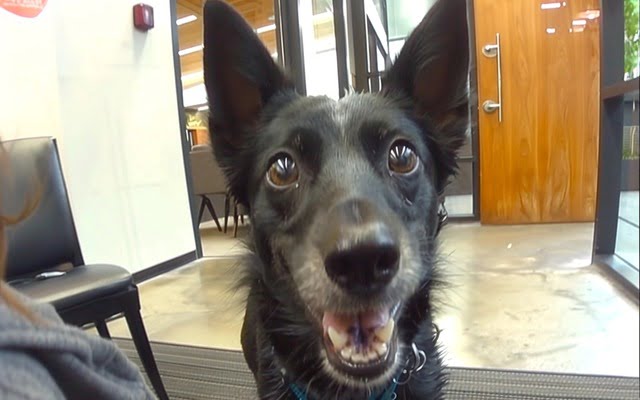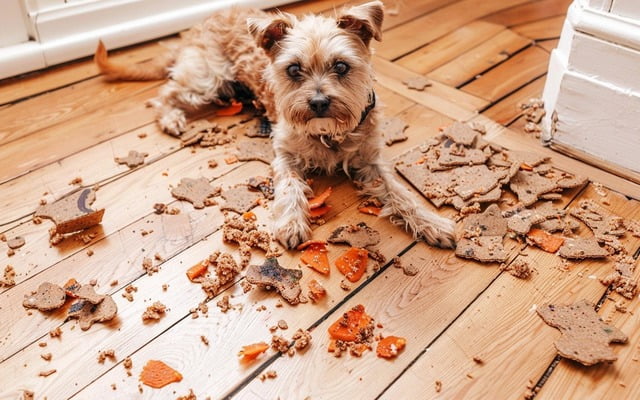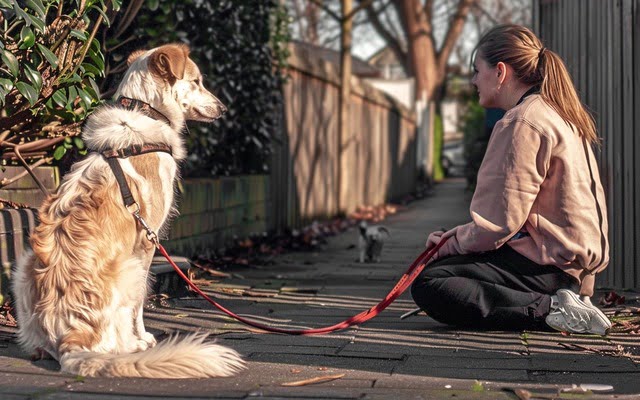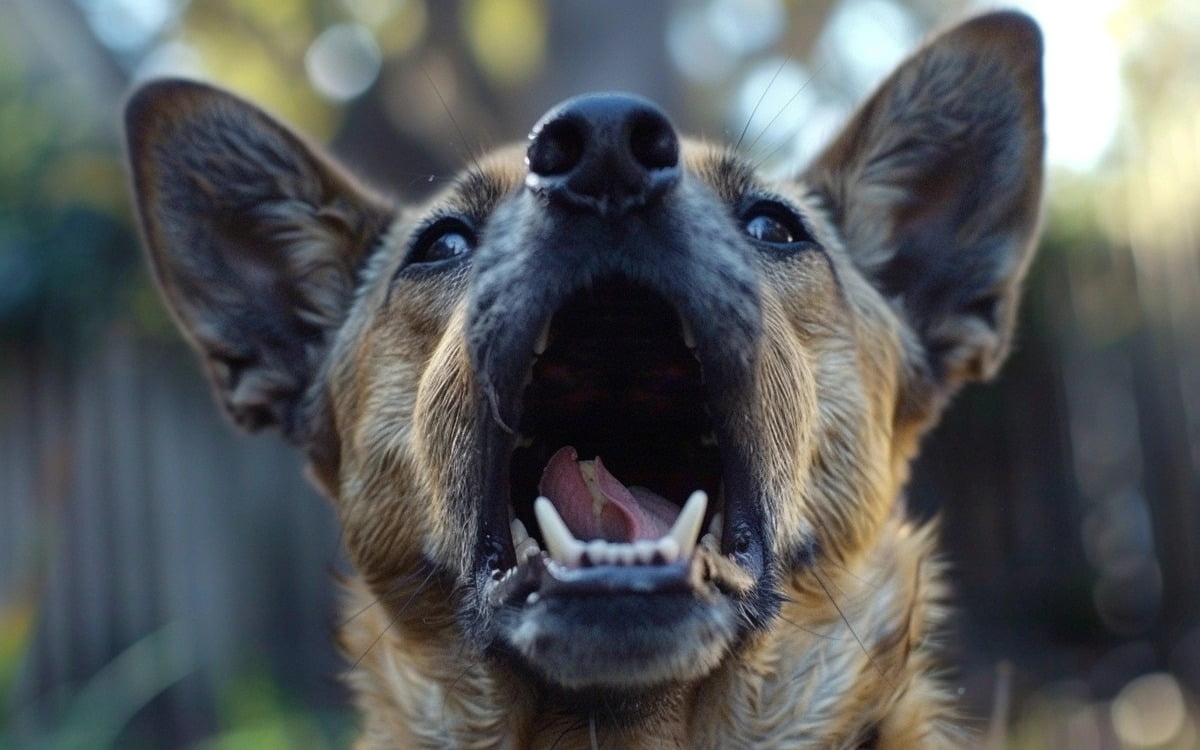A reactive dog is one that overreacts to certain triggers. Those triggers can be dogs, strangers, loud noises, bikes – just about anything! This typically looks like barking, lunging, growling and sometimes even snapping.
It’s important to know that a reactive dog isn’t a “bad” dog; they’re usually acting out of fear or anxiety. So let’s talk about why dogs become reactive in the first place.
Understanding the Underlying Emotions
Most often, reactive dogs are simply scared or anxious. But here’s the thing: Sometimes they’re also very frustrated! Think about it – dogs can’t talk to us and explain how they feel. So if they get put into a situation they don’t want to be in but can’t escape from, that barking and lunging might be their way of saying “Hey, I need some more space!”
It really is like that kid throwing an absolute fit in the grocery store – they’re trying to tell us something important, but it doesn’t always come out in the best way.

Recognizing Reactive Dog
So how do you know if your dog is reactive? Here’s a quick checklist:
- They intensely bark or growl at specific triggers.
- They lunge towards people, dogs or objects.
- They have “whale eye” (when the whites of their eyes are showing).
- They cower or try to hide.
If your dog does any of these things regularly, it’s worth talking to a trainer or behaviorist who specializes in reactivity.
Living with a Reactive Dog
Management Techniques to Keep Everyone Safe
OK, so you’ve got a reactive dog. Now what? The first step is learning how to manage the situation so that everyone – including you, your dog and those around you – feels safe. Here are some tips:
- Be a Leash Ninja: A good harness and sturdy leash are your best friends. Avoid using extendable leashes as they offer very little control. Practice walking your dog with a loose leash while keeping distance between them and potential triggers.
- Muzzle Up: Muzzles get a bad rap but they can be life-savers for dogs with reactivity issues. A basket-style muzzle allows your dog to breathe and drink normally while preventing biting in emergencies. Always introduce a muzzle slowly and with lots of positive reinforcement!
- Avoidance is Key: Sometimes, the easiest way to prevent a reaction is by keeping away from known triggers. Choose quieter walking routes, go at off-peak times, and if you see another dog, cross the street or turn around. It’s not giving up; it’s setting your dog up for success.
- Unique Content: Indoor Triggers Reactive dogs struggle inside the home too! Here are some tips on desensitizing them to common household noises:
- Start by playing recordings of doorbells, barking, etc. at very low volume while giving treats.
- If your dog remains calm over many sessions, gradually increase the volume.
Importance of a Predictable Routine and Mental Stimulation
Dogs with anxiety love routine! Knowing what’s going to happen next reduces their stress levels. So here’s what you can do:
- Set Schedule: Feed your dog, walk them and play with them at roughly the same times every day. This creates a sense of safety for them.
- Puzzle Power: Invest in food puzzles or hide treats around the house for them to find. Mental stimulation tires dogs out just as much as physical exercise does – and helps reduce frustration making them less likely to react.
- Unique Content: Scent Games 101 Teach your dog basic “find it” games. Hide a treat and encourage them to sniff it out themselves! This is a great way of building confidence without putting too much pressure on those busy brains – tiring them out too!

Training a Reactive Dog
Enlisting the Help of a Professional Trainer
While you can absolutely get started on your own – finding someone who specializes in reactivity or fear-based behaviours using positive reinforcement methods is the best thing for reactive dogs. A qualified trainer or behaviourist can assist in developing a tailor-made training plan based on your individual dog’s needs and teach you how to read their subtle stress signals.

Core Training Techniques: Desensitization and Counterconditioning
These two techniques are the keys to changing your dog’s emotional response to scary stuff! Here’s the basic idea:
- Desensitization: Gradually expose your dog to a trigger from a distance where they don’t react. This might mean seeing another dog across the street at first. Reward them like crazy for staying calm!
- Counterconditioning: Pair the trigger with something your dog LOVES. This helps them build a positive association, instead of a fearful one.
- Example: Let’s say your dog goes nuts when they see other dogs. Here’s how to practice:
- Find a spot where you see dogs in the distance but your dog remains calm.
- The MOMENT they see the dog, throw a handful of treats on the ground.
- Overtime move closer over many sessions, always rewarding calm behavior.
Building Communication and Positive Reinforcement
Training a reactive dog isn’t only about addressing the trigger itself – it’s about building strong communication skills between you and your pooch so that you can help them through difficult situations together
Celebrate the Small Wins
While setbacks can be discouraging, it’s important to celebrate the small wins along the way. Here are some examples of progress worth acknowledging:
- Increased tolerance: Did your dog walk past a trigger without reacting? That’s huge!
- Improved body language: Is your dog starting to relax or offer calming signals in stressful situations? Fantastic!
- Better coping skills: Did your dog look at you for guidance instead of barking/lunging? Amazing job!
- Featured snippet suggestion: Address a frequently asked question, such as “My dog had a setback in training! Does this mean we’re failing?” Follow it with the answer: “Not at all! For anyone trying to learn – especially dogs dealing with big emotions – setbacks are part of the process. Adjust your plan, be patient, and celebrate tiny bits of progress.”
With reactive dogs, progress often comes in baby steps – and that’s okay! Recognizing each small success will keep you going even when things get tough. Did your dog see another dog and only bark once when they used to bark ten times? That’s a win! Did they walk past a stranger without lunging? Celebrate! Focusing on what goes right reinforces good behavior and shows you how far you’ve come.
Conclusion
Living with a reactive dog can be challenging but also an amazing opportunity for personal growth and understanding between you two. With patience, dedication, and the right tools any person may establish incredible connection with their furry friend who will feel secure next to them always knowing they are understood. Remember – it’s not about “fixing” our pets but giving them everything that is necessary for flourishing!
FAQs
You can integrate this directly into your article or have a dedicated FAQ section.
Is my dog reactive or just aggressive? A: It can sometimes be difficult to distinguish between reactivity and aggression in dogs but it’s important because treatment methods differ greatly depending on which one we’re dealing with. Reactive animals usually act out due to fear or anxiety whereas aggressive ones may show more dominant behaviors; therefore consulting certified animal behaviorist would help achieve accurate diagnosis.
What should I do if my reactive dog encounters an off-leash dog?
Try these strategies when safety becomes priority number one:
- Create distance – turn around and walk away calmly without engaging other dog
- Distract – throw high value treats on ground for your pet to find instead of focusing attention elsewhere
- Block – if needed, place yourself between approaching dogs so they can’t get close together
- Seek help – if situation escalates loudly ask owner recall their animal.
My dog is only reactive on the leash. Does this still considered reactivity?
Yes, absolutely! Leash reactivity is a common problem among dogs. Being restrained by leash can make them feel trapped or vulnerable which leads to anxiousness around triggers resulting in display of aggressive behaviors towards other animals passing by.
Can a reactive dog ever be fully ‘cured’?
Many reactive dogs do not completely get rid of their issues but show tremendous improvement through continuous training and proper care. You know that you’re successful when your pet’s confidence increases, it learns coping mechanisms as well as starts feeling more comfortable in different environments while exhibiting less severe reactions over time.
My reactive dog gets along with some dogs but not others. Why is that?
Just like humans, animals have preferences too! Your furry friend may have had negative encounters with certain breeds or sizes before therefore leading to such response. Besides, insecure pets tend to be more reactive towards hyperactive ones during playtime.

I’m Ashley Fowler and dogs have always been my companions from my earliest memories. Growing up, our family dog was my confidant, adventure buddy and sometimes partner in crime (sorry mom, about the chewed shoes!). That bond sparked a lifelong passion for learning about dogs – their unique personalities, their histories, and the special ways they fit into our lives. MDogsW is my way of sharing that passion and hopefully helping others experience the joy of finding their perfect puppy. When I’m not researching dog breeds, you can usually find me hiking with my trusty Beagle by my side or curled up with a cozy blanket, a cup of tea, and a stack of dog breed books.


